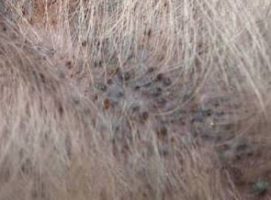This post may contain affiliate links. Please read our disclosure.
What causes black spots on a dog’s skin? Can they be treated or removed? If your dog has black dots on the belly, skin, or near its privates, this article will inform you of effective ways to deal with them.
In this article I will also elaborate on how to deal with crusty scabs or rashes on the skin using shampoos and other chemicals such as Miconazole creams.
Article Contents
My Dog Is Getting Black Spots on her Skin
Dark spots can be stressful for both the dog owners and the dogs. The owners never like to see their dog have any sort of abnormality and seeing dark spots can worry some owners if they don’t know what it could be from.

Several dog owners are not aware of the causes of the dog’s black spots and might, therefore, fail to find the appropriate remedy to address such black spots issue.
7 Causes of Black Spots on Dog’s Skin & Belly
There are several causes of black spots on dog’s skin including:
#1 Thyroid deficiency
If you notice that your dog has black spots that are tender to touch and are changing in shape and size. This is an indication that your dog has a thyroid condition. With a thyroid condition, the dog will lose some hair. This then makes the black spots to be more visible.
Hypothyroidism happens when your dog is not secreting enough of the thyroid hormones, causing your dog’s metabolism to slow down. This condition is more common in dogs than in other types of domestic animals, but it usually responds well to appropriate medication given by a vet.
#2 Secondary Acanthosis Nigricans
The Secondary type of Acanthosis Nigricans are more common than the primary form of the condition and can affect any dog, regardless of the breed. The disease is caused by friction, which is due to hormonal imbalances, the dog’s obesity, or hypersensitivity to food. This disease results in increased black spots in the dog’s skin.
#3 Acanthosis Nigricans
Acanthosis Nigricans is an uncommon cutaneous reaction pattern characterized by axillary hyperpigmentation, lichenification, and alopecia.This condition is rare and primarily affects puppies that are less than one year old. Also, the condition usually only affects Dachshund breeds. When your dog is affected by the disease, its skin thickens, and black spots appear on its skin.
#4 Hemorrhage
Hemorrhage is a bleeding condition that is commonly known as vasculitis because of its reference to the blood vessels. When the dog is bruised, the blood capillaries below the skin get ruptured. As the blood comes out, some will be trapped below the skin. This will cause skin discolouration and black spots above the trapped blood.
#5 The Sun
The presence of melanin protects the dog from harmful ultraviolet rays emitted by the sun. The rays are dangerous and can cause dark spots on your dog’s belly. If your dog stays away from the harsh rays on extremely sunny days, the dark spots should go away within 1-2 weeks.
#6 Aging
When your dog is old, it develops age spots, which are dark in color.
These dark spots due to age are not harmful, and therefore, individuals are usually advised to know the ages of their dogs in order to rule this type out.
#7 Allergies
When the dog is allergic to some environmental factors, it might show some signs including the appearance of dark spots on the belly.
Black Patches or Scabs on Dog’s Skin
Black patches and scabs are different than black spots. They cover a wider area of the skin normally and are all black where spots mostly look like little black circles.
Sometimes the black patches can occur naturally. They can be seen in areas of friction such as legs, and armpits. However, when the dog is allergic to something, you are likely to notice the black patches on their skin.
Therefore, you should watch your dog careful to be able to differentiate between these two types. You could also remove anything new that may have caused allergies the see if that helps get rid of the black spots.
The Dog has Black Spots on the Skin and Losing Hair
In some cases, you may notice that the occurrence of black spots results in the loss of the dog’s hair. This is often due to an infection and it is recommended that you monitor these changes and call your vet.
Black spots near dog’s privates
Near the dog’s privates, you may also notice black spots if the dog is infected with the yeast fungus. The infection may result in excessive itching and a foul smell.
When you see these, visit the nearest physician to be given the right medication that will help in treating the yeast infection and eventually eliminate the black spots.
Brown Rash on Dog’s Belly
Similar to black spots, there are several causes of a brown rash on the dog’s belly (most are the same), these include:
- Allergic reactions
- Irritated skin
- Bacterial infections
- Dermatitis
Additionally, the rashes can be a result of yeast infections, bites by mites, and dermal parasites.
In case you notice the brown rashes consult the veterinarian to be given the right treatments, which will heal the condition quickly.
How to Treat Black Spots on Dog’s Skin
Treatment of the black spots on the dog’s skin varies, depending on the cause of the black spot. For instance, if the cause of black spots is hypothyroidism, you can give the dog thyroid supplements, from a vet, on a daily basis.
The drug that can be given to the dog if the cause of the black spots is hypothyroidism is Levothyroxine. The dosage will differ depending on the dog affected, age, and bleed.
If the cause of black spots is yeast infections, make sure you treat it as soon as possible. In this particular case, you can treat yeast infections using:
- Using shampoos with either 1% benzoyl peroxide, ketoconazole, sulfur, or chlorhexidine.
- Injections and oral medications can be applied, more especially, if the topical medications have failed.
- Miconazole creams can be used in cases where the yeast infection is localized.
Therefore, it is important that you identify the cause of your dog’s black spots so that you can administer the correct remedy. If you are unsure of the cause, take your dog to your vet and see if they have any ideas on what it could be.
Buy products for dog’s black spots
If you wish to erdaivcate the dog’s blackspots by yourself, you may consider buying the relevant prodcts from the stores.
Most of these products, includinhg shampoos do not necessarily need aprescription from the veterinnarian.
Some of the effective skin products you can buy on Amazon include:
- Veterinary Formula Clinical Care Antiparasitic & Antiseborrheic Medicated Shampoo For Dogs
- Arava Natural Medicated Dog Shampoo
- Vet’s Best Hot Spot Itch Relief Shampoo for Dogs
READ MORE:
 Petnile Comprehensive Pet Care Guides
Petnile Comprehensive Pet Care Guides



